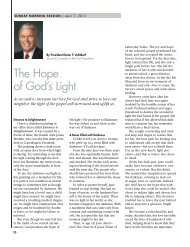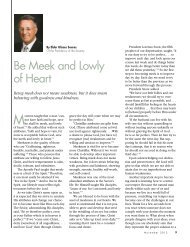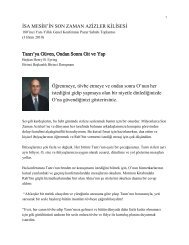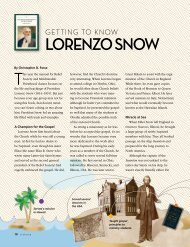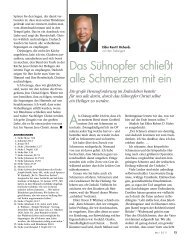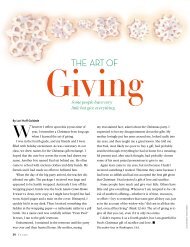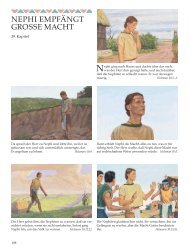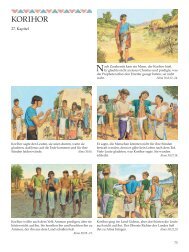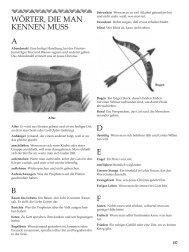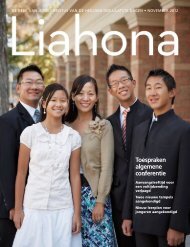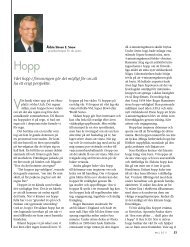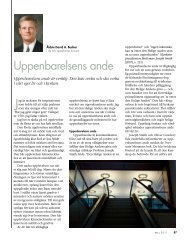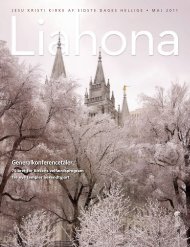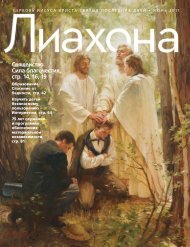July 2004 Ensign - The Church of Jesus Christ of Latter-day Saints
July 2004 Ensign - The Church of Jesus Christ of Latter-day Saints
July 2004 Ensign - The Church of Jesus Christ of Latter-day Saints
Create successful ePaper yourself
Turn your PDF publications into a flip-book with our unique Google optimized e-Paper software.
50<br />
lines to receive them; I was<br />
placed on the extreme right,<br />
to wheel in after the bodies,<br />
and march to the Mansion.<br />
As we passed the Temple,<br />
there were crowds <strong>of</strong> mourners<br />
there, lamenting the great<br />
loss <strong>of</strong> our Prophet and<br />
Patriarch. <strong>The</strong> scene was<br />
enough to almost melt the<br />
soul <strong>of</strong> man. Mr. Brewer,<br />
myself and others took<br />
brother Joseph’s body in to<br />
the Mansion House. . . . At<br />
midnight [we] carried the<br />
body <strong>of</strong> Joseph from the<br />
Mansion House to the<br />
Nauvoo House, and put<br />
him and Hyrum in<br />
one grave. <strong>The</strong>ir<br />
death was hard to<br />
bear. Our hope was<br />
almost gone, not<br />
knowing then that<br />
Joseph had prepared<br />
for the<br />
Kingdom to go on,<br />
by delivering the<br />
keys to the Twelve<br />
and rolling <strong>of</strong>f the burden from his shoulders on to theirs”<br />
(p. 231).<br />
Ordained a Bishop in Nauvoo<br />
Five months after the Martyrdom, President Brigham<br />
Young, assisted by Elder Heber C. Kimball and Presiding<br />
Bishop Newell K. Whitney, ordained Edward Hunter a<br />
high priest. He was then set apart as a bishop <strong>of</strong> the<br />
Nauvoo Fifth Ward. When he was promised that he should<br />
“have power to raise up the drooping spirit,” he felt simultaneously<br />
“a remarkable sensation thrilled through his<br />
THE POSITION OF PRESIDING BISHOP<br />
<strong>The</strong> Presiding Bishopric consists <strong>of</strong> three men—the<br />
Presiding Bishop and his two counselors—who make<br />
up one <strong>of</strong> the presiding councils <strong>of</strong> <strong>The</strong> <strong>Church</strong> <strong>of</strong> <strong>Jesus</strong><br />
<strong>Christ</strong> <strong>of</strong> <strong>Latter</strong>-<strong>day</strong> <strong>Saints</strong>. <strong>The</strong>se General Authorities, who<br />
each hold the <strong>of</strong>fice <strong>of</strong> bishop, serve in their positions under<br />
the direct supervision <strong>of</strong> the First Presidency. Since its formation,<br />
the Presiding Bishopric has been responsible for many<br />
<strong>of</strong> the temporal affairs <strong>of</strong> the <strong>Church</strong>. <strong>The</strong>se have included<br />
involvement in receiving, distributing, and accounting for<br />
member tithes, <strong>of</strong>ferings, and contributions; administration <strong>of</strong><br />
programs to assist the poor and needy; design, construction,<br />
and maintenance <strong>of</strong> places <strong>of</strong> worship; and auditing and transferring<br />
records <strong>of</strong> membership. Men chosen to be Presiding<br />
Bishops have been recognized for their business and management<br />
skills as well as their religious commitment.<br />
By scriptural designation the First Presidency, the Quorum<br />
<strong>of</strong> the Twelve Apostles, and the Presiding Bishopric constitute<br />
the Council on the Disposition <strong>of</strong> Tithes (see D&C 120). This<br />
council monitors the receipt <strong>of</strong> tithes and controls the expenditure<br />
<strong>of</strong> funds. It considers matters <strong>of</strong> financial importance and<br />
authorizes budgets for <strong>Church</strong> organizations and departments.<br />
(See Daniel H. Ludlow, ed., Encyclopedia <strong>of</strong> Mormonism,<br />
5 vols. (1992), 3:1129.)<br />
Below: <strong>The</strong> current Presiding Bishopric: H. David Burton,<br />
Presiding Bishop (center); Richard C. Edgley, First Counselor<br />
(left); and Keith B. McMullin, Second Counselor (right).<br />
being, confirming the truth<br />
<strong>of</strong> the speaker’s words”<br />
(p. 231).<br />
Elder Orson F. Whitney<br />
wrote <strong>of</strong> Bishop Hunter’s<br />
character: “Honest, straightforward<br />
in his dealings, and<br />
candid even to bluntness in<br />
his speech, his heart overflowed<br />
with kindness and<br />
he enjoyed the love and<br />
confidence <strong>of</strong> all. Childlike<br />
and humble, he was nevertheless<br />
shrewd and discerning.<br />
He was charitable and<br />
open-handed to all. . . . He<br />
was a great exhorter to<br />
faithfulness, particularly in<br />
the payment <strong>of</strong><br />
tithes and <strong>of</strong>ferings.<br />
His familiar speech<br />
at the Bishop’s<br />
meetings: ‘Pay your<br />
tithing and be<br />
blessed,’ has passed<br />
into a proverb”<br />
(p. 232).<br />
When the <strong>Saints</strong><br />
were forced from<br />
Nauvoo, Bishop Hunter and many <strong>of</strong> the “Mormon<br />
Hollow <strong>Saints</strong>” left together in the spring or summer <strong>of</strong><br />
1846 and joined the main body <strong>of</strong> <strong>Latter</strong>-<strong>day</strong> <strong>Saints</strong> in<br />
Winter Quarters. Bishop Hunter had suffered from sickness<br />
in Iowa, but upon arrival at Winter Quarters, he again<br />
served as bishop.<br />
Winter Quarters to Salt Lake Valley<br />
As the hard winter <strong>of</strong> 1846–47 ended and the<br />
exodus to the Salt Lake Valley began, President Young<br />
appointed Bishop Hunter captain <strong>of</strong> 100 wagons. <strong>The</strong>



